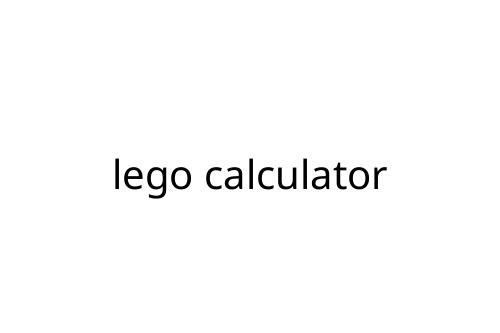lego calculator
A lego calculator sounds quirky, but it’s more practical—and fun—than you might think. Whether you’re a parent, a student, or simply a LEGO enthusiast, this fusion of play and math tool can bring a creative edge to daily calculations. Let’s break down what a lego calculator actually is, explore its uses, and help you decide if it’s worth adding to your desk or classroom.
What is a Lego Calculator?
There are two main types of lego calculator. First, there’s the electronic calculator designed to look like it's made of LEGO bricks. These are fully functioning calculators with buttons shaped and colored like LEGO pieces. Second, there’s the DIY approach—people build a calculator housing or even a full non-electronic counting device from LEGO bricks. In either form, the idea is to pair mathematics and creativity.
Why Use a Lego Calculator?
For most, traditional calculators do the job just fine. But a lego calculator offers a few distinct advantages:
- Engagement: Kids are more likely to use and enjoy something that resembles their favorite toy. A lego calculator can boost interest in basic math.
- Motivation: In the classroom, it’s a motivational tool. When math feels like play, students are less hesitant to make mistakes and try new approaches.
- Customization: With the DIY version, the sky’s the limit in terms of design. You can create a calculator that matches your personality or your workspace.
- Collectibility: LEGO enthusiasts often collect these themed gadgets, adding a fun, practical item to their displays.
How to Use a Lego Calculator
If you’re using a pre-made lego calculator, operation is the same as any standard calculator—just press the familiar LEGO-style buttons for your sums or algebra. For children, this can help bridge playtime and learning.
If you’re going the DIY route, you can either purchase a calculator kit that’s compatible with LEGO bricks or modify an old calculator’s casing. Building the shell from bricks supports creative problem-solving. Some advanced hobbyists have even attempted functional calculators by integrating LEGO Mindstorms or similar electronics kits.
Pros and Cons
Pros
- Engaging for kids and beginners
- Visually appealing, especially for LEGO fans
- Customizable or collectible
- Durable (especially in brick-built housings)
Cons
- Gimmicky for serious use—most options are basic calculators, not scientific models
- Pre-made versions may be pricier than standard calculators
- Keys can be less tactile or harder to press for some users
- DIY builds may not be a perfect fit for electronic parts
Practical Tips
If you’re considering a lego calculator for the classroom, choose a reputable model with sturdy construction. For DIY builds, ensure your calculator’s internals fit snugly in your design, and be cautious with homemade electronics.
Final Thoughts
A lego calculator won’t replace your smartphone’s advanced functions, but it will prompt curiosity and make math more approachable—especially for young learners. Whether you’re buying one or creating your own, it’s a clever mashup of creativity and computation. If you want math to feel less like a chore and more like a game, this odd little gadget is worth a try.
